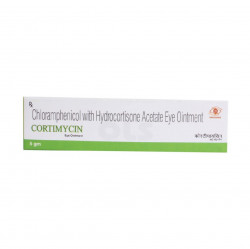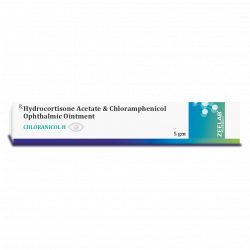Download India's most affordable pharmacy app
- Compare with medicine prices
- Save upto 90% on your medicine bills
DESCRIPTION:
Cortimycin Eye Ointment is a combination medicine that contains Hydrocortisone Acetate (0.5% w/w) and Chloramphenicol (1% w/w). It is primarily used for treating bacterial infections and inflammation of the eyes. Hydrocortisone Acetate is a corticosteroid that reduces redness, swelling, and irritation, while Chloramphenicol is an antibiotic that fights bacterial growth. Together, they provide relief from discomfort and help restore eye health effectively. Cortimycin Eye Ointment is commonly prescribed by doctors to treat eye conditions such as conjunctivitis, blepharitis, and other bacterial infections. It is safe when used as directed by a healthcare professional.
Uses of Cortimycin Eye Ointment
- Bacterial Conjunctivitis: Cortimycin Eye Ointment is effective in treating bacterial conjunctivitis, an eye infection characterized by redness, irritation, itching, and discharge. It helps eliminate bacteria and provides soothing relief from symptoms.
- Blepharitis: This medicine is used for blepharitis, an inflammatory condition of the eyelids caused by bacteria. It reduces swelling, redness, and irritation while preventing the infection from worsening.
- Keratitis: Cortimycin Eye Ointment is also prescribed for bacterial keratitis, which is an infection of the cornea. It helps kill harmful bacteria, reduces inflammation, and supports faster healing of the eye.
- Eye Inflammation due to Infection: It is beneficial in treating eye inflammation caused by bacterial infections. The dual-action formula provides relief by controlling infection and minimizing discomfort from swelling and redness.
How Cortimycin Eye Ointment Works
Cortimycin Eye Ointment combines the power of Hydrocortisone Acetate, which reduces inflammation, swelling, and redness, with Chloramphenicol, an antibiotic that inhibits bacterial protein synthesis, thereby stopping bacterial growth and infection effectively.
Benefits of Cortimycin Eye Ointment
- Provides quick relief from eye redness, swelling, and irritation
- Fights bacterial infections effectively
- Supports faster healing of eye conditions
- Prevents recurrence of bacterial eye infections
- Combines anti-inflammatory and antibacterial properties in one ointment
How to Take Cortimycin Eye Ointment
Wash your hands before use. Apply a small amount of ointment inside the lower eyelid as directed by your doctor. Avoid touching the tube tip to prevent contamination. Use regularly for best results.
What Should I Do If I Miss a Dose?
If you miss a dose, apply it as soon as you remember. If it is almost time for your next dose, skip the missed one and continue with your regular schedule. Do not double the dose.
Storage
Store Cortimycin Eye Ointment in a cool, dry place away from direct sunlight and moisture. Keep it tightly closed and out of reach of children. Do not freeze the medicine.
Drug Warnings
- Pregnancy: Use only if prescribed by a doctor.
- Breastfeeding: Consult your doctor before use.
- Liver/Kidney Issues: Patients with severe conditions should take medical advice before use.
- Driving: Temporary blurred vision may occur, so avoid driving immediately after application.
Side Effects of Cortimycin Eye Ointment
- Temporary blurred vision
- Eye irritation or stinging
- Redness or itching
- Watery eyes
- Rare allergic reactions such as swelling or rash
Safety Advice
- Use Cortimycin Eye Ointment only as prescribed.
- Do not share it with others, even if they have similar symptoms.
- Avoid wearing contact lenses while using this ointment.
- Inform your doctor about any allergies or ongoing medications.
Frequently Asked Questions (FAQs)
Q: What is Cortimycin Eye Ointment used for?
A: Cortimycin Eye Ointment is used to treat bacterial eye infections such as conjunctivitis, blepharitis, and keratitis, providing relief from redness, swelling, irritation, and discomfort.
Q: Can Cortimycin Eye Ointment treat bacterial conjunctivitis?
A: Yes, it helps eliminate the bacteria causing conjunctivitis, reduces irritation, and provides quick relief from redness and discharge when used as prescribed by a healthcare professional.
Q: Is Cortimycin Eye Ointment effective for blepharitis?
A: Yes, this ointment is commonly prescribed for blepharitis to reduce eyelid swelling, irritation, and infection, supporting faster healing and relief from discomfort caused by bacterial infection.
Q: Can Cortimycin Eye Ointment be used for keratitis?
A: Yes, Cortimycin Eye Ointment helps treat bacterial keratitis by killing harmful bacteria, reducing inflammation, and supporting corneal healing, which restores normal eye function effectively and safely.
Q: How does Cortimycin Eye Ointment work?
A: It combines Hydrocortisone Acetate to reduce swelling and redness with Chloramphenicol, an antibiotic that stops bacterial growth, offering dual action for faster relief from eye infections.
Q: What are the common side effects of Cortimycin Eye Ointment?
A: Some users may experience mild side effects such as temporary blurred vision, irritation, stinging, or redness. These usually subside with time, but medical advice should be sought if severe.
Q: Can pregnant women use Cortimycin Eye Ointment?
A: Pregnant women should use Cortimycin Eye Ointment only if prescribed by a doctor, as safety during pregnancy has not been fully established. Always seek medical advice before use.
Q: Is Cortimycin Eye Ointment safe while breastfeeding?
A: Breastfeeding mothers should use it only under medical guidance. Although absorption into breast milk is low, professional consultation ensures safe use for both mother and child.
Q: Can I drive after applying Cortimycin Eye Ointment?
A: Driving is not advised immediately after applying this ointment, as it may cause temporary blurred vision. Wait until your vision clears before engaging in such activities.
Q: What precautions should I follow while using Cortimycin Eye Ointment?
A: Always wash hands before application, avoid touching the tube tip, do not share the ointment, and avoid contact lens use during treatment. Follow your doctor’s advice carefully for best results.
















 Added!
Added!